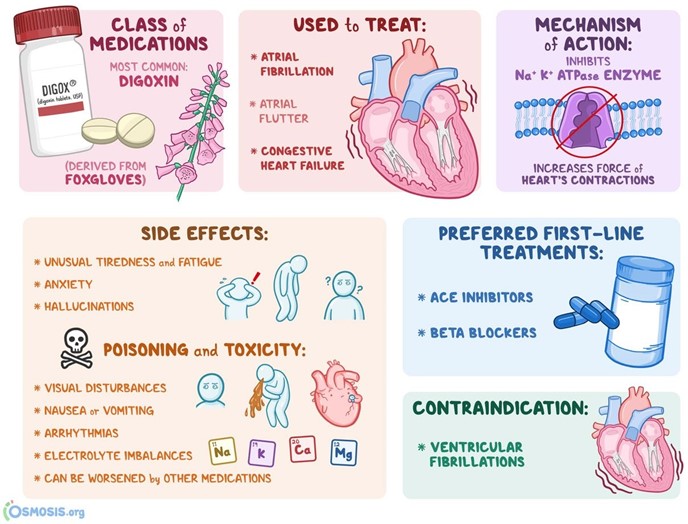Prior to giving digoxin, the practical nurse (PN) assesses that a 2-month-old infant's heart rate is 120 beats/minute. Based on this, what action should the PN take?
Administer the medication and alert the charge nurse
Hold the medication and document cardiac assessment
Administer the medication and document the heart rate
Hold the medication and recheck the heart rate in 1 hour
The Correct Answer is C
The correct answer and explanation is:
c) Administer the medication and document the heart rate.
This is the action that the PN should take prior to giving digoxin to a 2-month-old infant whose heart rate is 120 beats/minute. Digoxin is a cardiac glycoside that is used to treat heart failure and arrhythmias. It has a narrow therapeutic range and can cause serious side effects such as bradycardia, hypotension, and toxicity. Therefore, it is important to monitor the client's vital signs before and after administering the medication. A normal heart rate for a 2-month-old infant is 100–190 beats/minute, so 120 beats/minute is within the normal range and does not indicate a need to hold the medication. The PN should administer the medication as prescribed and document the heart rate and any other relevant findings.
a) Administer the medication and alert the charge nurse.
This is not the action that the PN should take prior to giving digoxin to a 2-month-old infant whose heart rate is 120 beats/minute. Alerting the charge nurse is not necessary, as the heart rate is normal and does not indicate a problem with the medication or the client's condition. The PN should administer the medication as prescribed and document the heart rate and any other relevant findings.
b) Hold the medication and document cardiac assessment.
This is not the action that the PN should take prior to giving digoxin to a 2-month-old infant whose heart rate is 120 beats/minute. Holding the medication is not appropriate, as the heart rate is normal and does not indicate a contraindication or a risk of adverse effects from the medication. The PN should administer the medication as prescribed and document the heart rate and any other relevant findings.
d) Hold the medication and recheck the heart rate in 1 hour.
This is not the action that the PN should take prior to giving digoxin to a 2-month-old infant whose heart rate is 120 beats/minute. Holding the medication and rechecking the heart rate in 1 hour is not necessary, as the heart rate is normal and does not indicate a need for further evaluation or intervention. The PN should administer the medication as prescribed and document the heart rate and any other relevant findings.
 |
Nursing Test Bank
Naxlex Comprehensive Predictor Exams
Related Questions
Correct Answer is B
Explanation
The correct answer is choiceb. Chest pain and dysrhythmia.
Choice A rationale:
Decreasing gastrointestinal (GI) cramping and nausea are not typical adverse effects of vasopressin.In fact, vasopressin can cause abdominal cramps and nausea as side effects.
Choice B rationale:
Chest pain and dysrhythmia are significant adverse effects of vasopressin.Vasopressin can cause vasoconstriction, leading to myocardial ischemia and arrhythmias.
Choice C rationale:
Vasodilation of the extremities is not an adverse effect of vasopressin.Instead, vasopressin typically causes vasoconstriction, which can lead to peripheral ischemia.
Choice D rationale:
Hypotension and tachycardia are not common adverse effects of vasopressin.Vasopressin is more likely to cause hypertension due to its vasoconstrictive properties.
Correct Answer is ["A","B","C","E"]
Explanation
Choice A rationale:
The client’s presentation of a noticeable facial droop and garbled speech are classic symptoms of a stroke. These symptoms indicate that the brain is not receiving enough oxygen, which can lead to permanent damage if not treated immediately. Therefore, this client requires immediate health interventions.
Choice B rationale:
This choice is identical to Choice A. The client’s noticeable facial droop and garbled speech are indicative of a stroke and require immediate attention.
Choice C rationale:
This choice is also identical to Choices A and B. The client’s symptoms are indicative of a stroke, which is a medical emergency that requires immediate intervention.
Choice D rationale:
While the change in the client’s speech after having a few drinks at a restaurant could be due to alcohol consumption, it could also be a symptom of a stroke, especially when combined with a facial droop. However, this choice does not directly indicate the need for immediate health interventions as it lacks the specificity of the symptoms compared to Choices A, B, and C.
Choice E rationale:
The time of arrival and mode of transportation do not directly indicate the need for immediate health interventions. However, the mention of facial drooping and garbled speech upon arrival at the emergency department reinforces the urgency of the situation, as these are classic symptoms of a stroke. In conclusion, Choices A, B, C, and E all highlight data that indicate the client is in need of immediate health interventions due to potential stroke symptoms. It’s important to note that strokes require immediate medical attention to minimize brain damage and potential complications. Normal ranges for lab parameters would not apply in this scenario as it’s based on clinical observations rather than laboratory findings.
Whether you are a student looking to ace your exams or a practicing nurse seeking to enhance your expertise , our nursing education contents will empower you with the confidence and competence to make a difference in the lives of patients and become a respected leader in the healthcare field.
Visit Naxlex, invest in your future and unlock endless possibilities with our unparalleled nursing education contents today
Report Wrong Answer on the Current Question
Do you disagree with the answer? If yes, what is your expected answer? Explain.
Kindly be descriptive with the issue you are facing.
